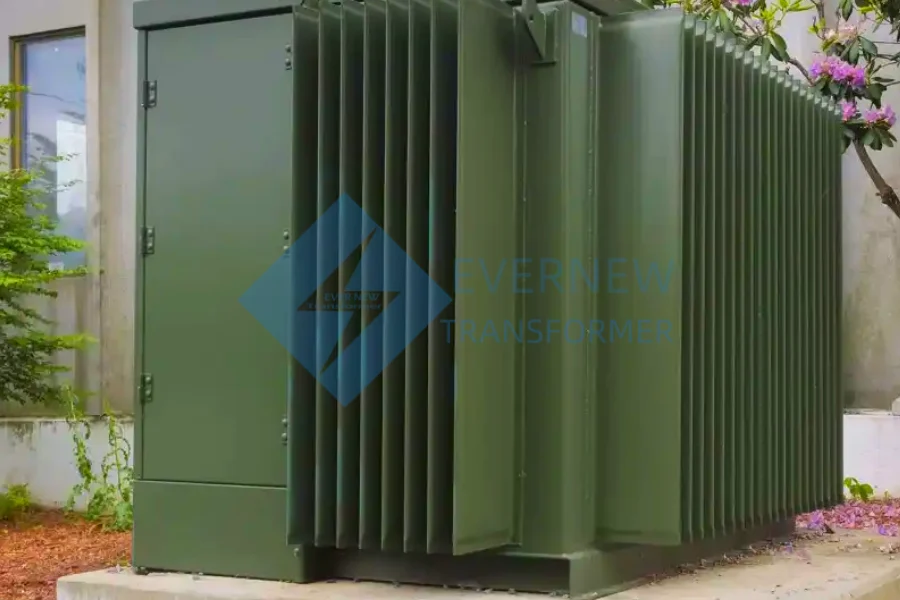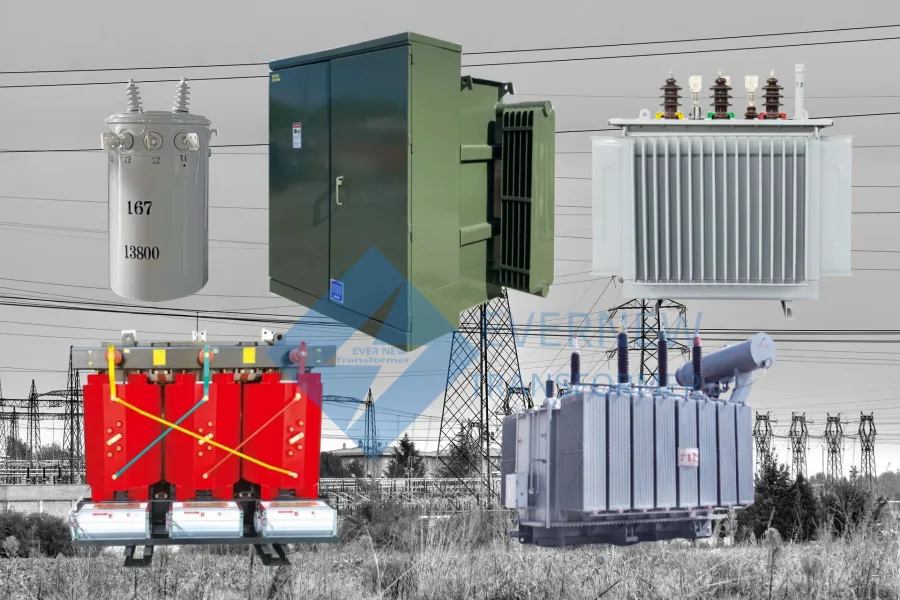변압기는 현대 전기 시스템에서 필수적이며, 특정 운영 요구 사항을 충족하기 위해 전압 레벨을 조정하는 데 중요한 역할을 합니다. 배전 네트워크에서, 배전 장비 변압기 발전소에서 생산된 전기가 주거용, 상업용, 산업용 등 최종 사용자에게 효율적이고 안전하게 전달되도록 보장합니다. 중국의 선도적인 변압기 제조업체인 에버뉴 트랜스포머는 전 세계 배전 요구 사항을 충족하도록 설계된 고품질 배전 장비 변압기를 생산합니다. 이 블로그에서는 변압기의 두 가지 주요 유형인 전력 변압기와 배전 변압기의 차이점, 용도 및 배전 시스템에서 중요한 역할을 강조하는 변압기에 대해 살펴봅니다.
전력 변압기란 무엇인가요?
A 전력 변압기 는 주로 장거리 전력 전송에 사용됩니다. 송전 네트워크의 요구 사항에 맞게 전압을 높이거나 낮추는 방식으로 작동합니다. 이러한 변압기는 일반적으로 756kV에서 11kV에 이르는 고전압 레벨을 처리합니다. 전력 변압기와 같은 배전 장비 변압기는 발전소 및 송전 변전소에서 발견되며, 효율적인 장거리 송전을 위해 전압을 조절합니다.
배전 장비 변압기는 정격 MVA(메가볼트암페어)가 높기 때문에 최대 부하에서 최소한의 변동으로 작동하도록 설계되어 많은 양의 전기가 최소한의 손실로 흐르도록 보장합니다. 이러한 변압기는 공간을 최소화하고 효율성을 높이기 위해 소비자와 멀리 떨어진 변전소와 같은 외진 곳에 위치하는 경우가 많습니다.
자세히 보기:세계 10대 전력 변압기 제조업체
배전 변압기란 무엇인가요?
전력 변압기와는 대조적입니다, 배전 변압기 는 가정, 기업 및 산업 시설에서 안전하고 사용 가능한 수준으로 전압 레벨을 낮추도록 설계되었습니다. 이러한 유형의 배전 장비 변압기는 일반적으로 33kV에서 430V 사이의 전압 수준에서 작동합니다. 이러한 변압기는 최종 사용자와 훨씬 더 가까운 곳에 설치되며 일상에서 전기를 안전하게 사용할 수 있도록 하는 데 중요한 역할을 합니다.
배전 변압기는 다수의 가정용 또는 산업용 사용자에게 서비스를 제공하는 경우가 많으며, 장비가 안전하고 효율적으로 작동하는 데 필요한 수준으로 전압을 낮추는 데 필수적입니다. 예를 들어, 대부분의 국가에서 가정은 120V 또는 240V 서비스를 받는 반면, 대규모 산업 시설에서는 전력 수요에 따라 480V 또는 600V와 같은 더 높은 전압 레벨이 필요할 수 있습니다.
자세히 보기:변전소 변압기 심층 분석
전력 및 배전 변압기의 주요 차이점
배전 설비 변압기와 배전 변압기는 모두 전압 레벨을 조정하는 역할을 하지만 설계, 사용 및 설치 측면에서 뚜렷한 차이점이 있습니다:
- 전압 범위: 배전 장비 변압기는 일반적으로 400kV ~ 33kV 범위의 높은 전압 레벨을 처리하는 반면, 배전 변압기는 일반적으로 33kV ~ 430V 범위의 낮은 전압 레벨을 처리합니다.
- 애플리케이션: 배전 설비 변압기는 고압 송전 네트워크에 사용되는 반면 배전 변압기는 저압 배전 네트워크에 사용됩니다.
- 크기 및 디자인: 배전 장비 변압기는 크기가 상당히 커서 설치 및 운영을 위한 특수 시설이 필요한 경우가 많습니다. 그러나 배전 변압기는 더 작고 최종 사용자와 가까운 도시 또는 교외 지역에 배치되는 경우가 많습니다.
- 로드 처리: 배전 장비 변압기는 일반적으로 최소한의 변동으로 최대 부하에서 작동하지만 배전 변압기는 수요 패턴에 따라 더 큰 부하 변화를 경험할 수 있습니다.

배전 시스템에서 변압기의 중요한 역할
배전 장비 변압기는 배전 시스템의 기능에 없어서는 안 될 필수 요소입니다. 그 이유는 다음과 같습니다:
1. 전압 조정
배전 장비 변압기는 네트워크의 여러 지점에서 전압 레벨을 조정합니다. 이러한 변압기는 장거리 송전을 위해 전압을 높이고 소비자 사용을 위해 전압을 낮춤으로써 전력 손실의 위험을 줄입니다. 예를 들어, 송전을 위해 전압을 높이면 전류가 낮아져 송전선의 저항(I²R 손실)으로 인한 손실이 줄어듭니다.
2. 에너지 효율성
고전압 송전은 저전압 송전보다 에너지 효율이 높습니다. 배전 장비 변압기를 사용하여 장거리 송전을 위해 전압을 높이면 송전선의 에너지 손실이 최소화됩니다. 이는 인프라 비용 절감으로 이어지고 전력망의 전반적인 효율성을 향상시킵니다.
3. 안전 및 신뢰성
배전 장비 변압기는 전압을 소비자가 사용하기에 안전한 수준으로 낮춰 안전을 유지하는 데 중요한 역할을 합니다. 배전 장비 변압기는 전압을 적절하게 조절함으로써 전기 서지 또는 전압 불균형으로 인한 잠재적 위험으로부터 전기 제품, 기계 및 최종 사용자를 보호합니다.
4. 설계의 유연성
배전 장비 변압기는 배전 네트워크 설계에 유연성을 제공합니다. 부하 요구 사항과 지리적 조건에 따라 이러한 변압기는 주거용, 상업용 또는 산업용 등 특정 요구 사항을 충족하도록 맞춤화할 수 있습니다.
5. 재생 에너지 통합
전 세계가 태양광, 풍력 등 재생 에너지원으로 전환함에 따라 배전 장비 변압기는 이러한 가변 에너지원을 전력망에 통합하는 데 점점 더 중요한 역할을 하고 있습니다. 배전 장비 변압기는 전압 변동을 관리하고 안정적인 전력 공급을 보장함으로써 재생 에너지를 국가 전력망에 원활하게 통합할 수 있도록 지원합니다.
자세히 알아보기:고전압 변압기에 대한 완벽한 가이드
배전 변압기의 종류
배전 변압기에는 여러 유형이 있으며, 각 변압기는 특정 전력 요구 사항을 충족하도록 설계되었습니다:
- 단상 변압기: 일반적으로 부하가 100kVA 미만인 소규모 주거용 애플리케이션에 사용됩니다.
- 3상 변압기: 일반적으로 100kVA를 초과하는 높은 전력 요구 사항을 가진 산업 및 상업용 애플리케이션을 위해 설계되었습니다.
- 건식 변압기: 이들 건식 변압기 는 화재 안전이 우선시되는 지역에서 사용됩니다. 오일 충전 변압기에 비해 더 콤팩트하고 유지보수가 덜 필요합니다.
- 오일 침지형 변압기: 고전압 및 전류 용량이 필요한 중공업 분야에 적합한 이 변압기는 냉각 및 절연을 위해 오일을 사용합니다.
무료로 받기:발전소 변압기란?
배전 변압기 사용의 이점
고품질 배전 장비 변압기를 사용하면 몇 가지 이점이 있습니다:
- 향상된 전력 품질: 배전 장비 변압기는 전압을 조절하여 소비자에게 일관되고 안정적인 전력 공급을 보장합니다.
- 에너지 절약: 배전 장비 변압기는 송전 손실을 줄이고 전력을 효율적으로 분배함으로써 에너지를 절약하고 비용을 절감하는 데 도움이 됩니다.
- 향상된 장비 수명: 안정적인 전압은 전기 장치와 기계가 설계된 매개 변수 내에서 작동하도록 보장하여 수명을 연장합니다.
- 안전 보장: 배전 장비 변압기는 전압을 안전한 수준으로 낮춤으로써 전기 사고 및 장비 고장의 위험을 줄여줍니다.
자세히 알아보기:2000 KVA 33KV 오일 타입 배전 변압기
결론
변압기는 발전소에서 생산된 전기가 소비자에게 효율적이고 안전하게 전달되도록 하는 현대 배전 시스템의 중추입니다. 에버뉴 트랜스포머고품질 배전 장비 변압기 제조에 전문성을 갖춘 에버뉴는 이 과정에서 중요한 역할을 합니다. 주거용, 상업용 또는 산업용 애플리케이션에 관계없이 Evernew의 배전 장비 변압기는 글로벌 배전 시장의 다양한 요구 사항을 충족하는 안정적이고 에너지 효율적인 솔루션을 제공하도록 설계되었습니다.
배전 장비 변압기의 역할과 이점을 이해하는 것은 가정, 기업 및 산업에 전력을 공급하는 전력망의 복잡한 설계를 이해하는 데 필수적입니다.

